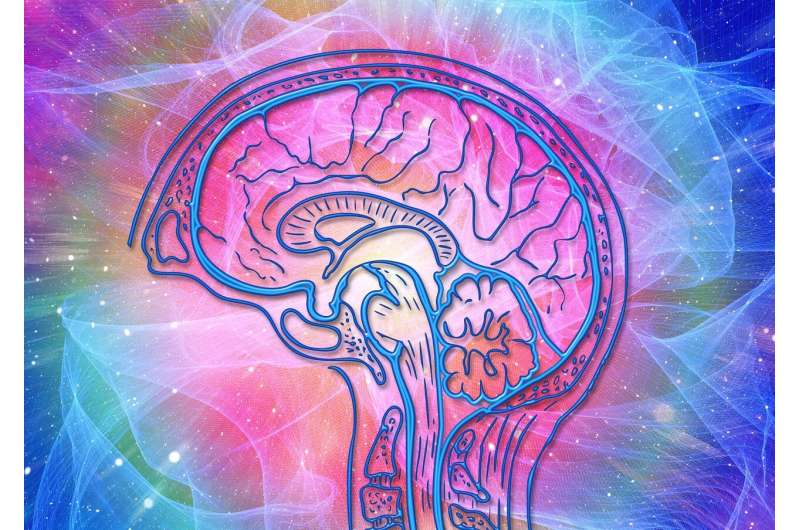This article has been reviewed according to Science X's editorial process and policies. Editors have highlighted the following attributes while ensuring the content's credibility:
fact-checked
peer-reviewed publication
trusted source
proofread
Schizophrenia and aging may share a common biological basis: Genetic changes in two types of brain cells

Researchers from the Broad Institute of MIT and Harvard, Harvard Medical School, and McLean Hospital have uncovered a strikingly similar suite of changes in gene activity in brain tissue from people with schizophrenia and from older adults. These changes suggest a common biological basis for the cognitive impairment often seen in people with schizophrenia and in the elderly.
In a study published in Nature, the team describes how they analyzed gene expression in more than a million individual cells from postmortem brain tissue from 191 people. They found that in individuals with schizophrenia and in older adults without schizophrenia, two brain cell types called astrocytes and neurons reduced their expression of genes that support the junctions between neurons called synapses, compared to healthy or younger people.
They also discovered tightly synchronized gene expression changes in the two cell types: when neurons decreased the expression of certain genes related to synapses, astrocytes similarly changed expression of a distinct set of genes that support synapses.
The team called this coordinated set of changes the Synaptic Neuron and Astrocyte Program (SNAP). Even in healthy, young people, the expression of the SNAP genes always increased or decreased in a coordinated way in their neurons and astrocytes.
"Science often focuses on what genes each cell type expresses on its own," said Steve McCarroll, a co-senior author on the study and an institute member at the Broad Institute. "But brain tissue from many people, and machine-learning analyses of those data, helped us recognize a larger system. These cell types are not acting as independent entities, but have really close coordination. The strength of those relationships took our breath away."
Schizophrenia is well-known for causing hallucinations and delusion, which can be at least partly treated with medications. But it also causes debilitating cognitive decline, which has no effective treatments and is common in aging as well. The new findings suggest that the cognitive changes in both conditions might involve similar cellular and molecular alterations in the brain.
"To detect coordination between astrocytes and neurons in schizophrenia and aging, we needed to study tissue samples from a very large number of individuals," said Sabina Berretta, a co-senior author of the study, an associate professor at Harvard Medical School, and a researcher in the field of psychiatric disorders.
"Our gratitude goes to all donors who chose to donate their brain to research to help others suffering from brain disorders and to whom we'd like to dedicate this work."
McCarroll is also director of genomic neurobiology for the Broad's Stanley Center for Psychiatric Research and a professor at Harvard Medical School. Berretta also directs the Harvard Brain Tissue Resource Center (HBTRC), which provided tissue for the study. Emi Ling, a postdoctoral researcher in McCarroll's lab, was the study's first author.
SNAP insights
The brain works in large part because neurons connect with other neurons at synapses, where they pass signals to one another. The brain constantly forms new synapses and prunes old ones. Scientists think new synapses help our brains stay flexible, and studies—including previous efforts by scientists in McCarroll's lab and international consortia—have shown that many genetic factors linked to schizophrenia involve genes that contribute to the function of synapses.
In the new study, McCarroll, Berretta, and colleagues used single-nucleus RNA sequencing, which measures gene expression in individual cells, to better understand how the brain naturally varies across individuals. They analyzed 1.2 million cells from 94 people with schizophrenia and 97 without.
They found that when neurons boosted expression of genes that encode parts of synapses, astrocytes increased the expression of a distinct set of genes involved in synaptic function. These genes, which make up the SNAP program, included many previously identified risk factors for schizophrenia. The team's analyses indicated that both neurons and astrocytes shape genetic vulnerability for the condition.
"Science has long known that neurons and synapses are important in risk for schizophrenia, but by framing the question a different way—asking what genes each cell type regulates dynamically—we found that astrocytes too are likely involved," said Ling.
To their surprise, the researchers also found that SNAP varied greatly even among people without schizophrenia, suggesting that SNAP could be involved in cognitive differences in healthy humans. Much of this variation was explained by age; SNAP declined substantially in many—but not all—older individuals, including both people with and without schizophrenia.
With better understanding of SNAP, McCarroll says he hopes it might be possible to identify life factors that positively influence SNAP, and develop medicines that help stimulate SNAP, as a way to treat the cognitive impairments of schizophrenia or help people maintain their cognitive flexibility as they age.
In the meantime, McCarroll, Berretta, and their team are working to understand if these changes are present in other conditions such as bipolar disorder and depression. They also aim to uncover the extent to which SNAP appears in other brain areas, and how SNAP affects learning and cognitive flexibility.
More information: Ling E et al., A concerted neuron–astrocyte program declines in ageing and schizophrenia, Nature (2024). DOI: 10.1038/s41586-024-07109-5. www.nature.com/articles/s41586-024-07109-5



















